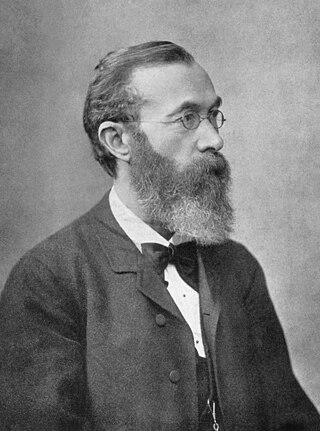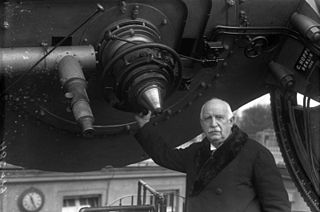
Max Karl Ernst Ludwig Planck was a German theoretical physicist whose discovery of energy quanta won him the Nobel Prize in Physics in 1918.

Wilhelm Maximilian Wundt was a German physiologist, philosopher, and professor, one of the fathers of modern psychology. Wundt, who distinguished psychology as a science from philosophy and biology, was the first person ever to call himself a psychologist.

Walther Wilhelm Georg Bothe was a German nuclear physicist who shared the Nobel Prize in Physics in 1954 with Max Born.

Max Theodor Felix von Laue was a German physicist who received the Nobel Prize in Physics in 1914 for his discovery of the diffraction of X-rays by crystals.

The Max Planck Society for the Advancement of Science is a formally independent non-governmental and non-profit association of German research institutes. Founded in 1911 as the Kaiser Wilhelm Society, it was renamed to the Max Planck Society in 1948 in honor of its former president, theoretical physicist Max Planck. The society is funded by the federal and state governments of Germany.

Manfred baron von Ardenne was a German researcher and applied physicist and inventor. He took out approximately 600 patents in fields including electron microscopy, medical technology, nuclear technology, plasma physics, and radio and television technology. From 1928 to 1945, he directed his private research laboratory Forschungslaboratorium für Elektronenphysik. For ten years after World War II, he worked in the Soviet Union on their atomic bomb project and was awarded a Stalin Prize. Upon his return to the then East Germany, he started another private laboratory, Forschungsinstitut Manfred von Ardenne.

The Kaiser Wilhelm Society for the Advancement of Science was a German scientific institution established in the German Empire in 1911. Its functions were taken over by the Max Planck Society. The Kaiser Wilhelm Society was an umbrella organisation for many institutes, testing stations, and research units created under its authority.

Friedrich Simon Archenhold was an astronomer who founded the Treptow Observatory in Berlin-Treptow. He graduated from the Realgymnasium in Lippstadt before entering Friedrich Wilhelm University in 1882, where he and Wilhelm Förster founded the Urania Society at the Berlin University Observatory.

The German Academy of Sciences at Berlin, German: Deutsche Akademie der Wissenschaften zu Berlin (DAW), in 1972 renamed the Academy of Sciences of the GDR, was the most eminent research institution of East Germany.

Friedrich A. Kittler was a literary scholar and a media theorist. His works relate to media, technology, and the military.
Wolfgang Gentner was a German experimental nuclear physicist.

The Berlin-Brandenburg Academy of Sciences and Humanities, abbreviated BBAW, is the official academic society for the natural sciences and humanities for the German states of Berlin and Brandenburg. Housed in three locations in and around Berlin, Germany, the BBAW is the largest non-university humanities research institute in the region.

Claudia Kemfert is a German economics expert in the areas of energy research and environmental protection. She is a Professor of Energy Economics and Sustainability at the Hertie School of Governance in Berlin. She heads the Energy, Transportation, and Environment department at the German Institute for Economic Research.

Rudolf Walter Ladenburg was a German atomic physicist. He emigrated from Germany as early as 1932 and became a Brackett Research Professor at Princeton University. When the wave of German emigration began in 1933, he was the principal coordinator for job placement of exiled physicists in the United States. Albert Einstein gave the eulogy at Rudolf's funeral. He and his wife Elsa had three children, Margarethe, Kurt, and Eva. Kurt had two children, Toni and Nils Ladenburg.
Christoph Röhl is a British-German filmmaker.

Otto Rippert was a German film director during the silent film era.

Sergius Nikolajewitsch von Bubnoff was a geologist and geotechnical engineer with Germano-Baltic ancestry who made important contributions to the rebuilding of geological research in East Germany after World War II. Starting in 1922, he was a professor at the University of Breslau. In 1929 he became a professor at the University of Greifswald and in 1950, he started his professorship at the Humboldt-University of Berlin. The Bubnoff unit, which is the unit of measure for the speed of geological processes, is named after him.

Homunculus is a 1916 German silent science fiction serial film directed by Otto Rippert and written by Robert Reinert. Other sources list Robert Neuss as a co-writer. Fritz Lang was one of Rippert's assistants during filming. It was originally produced by Deutsche Bioscop GmbH.
Karl Söllner was an Austrian-American chemist, primarily active in the field of physical chemistry and biophysics.

The Bamberg-Refraktor is a large telescope. The refracting telescope has an aperture of 320 millimetres, a focal length of five metres and is located in the Wilhelm Foerster Observatory in the Berlin district of Schöneberg.

















